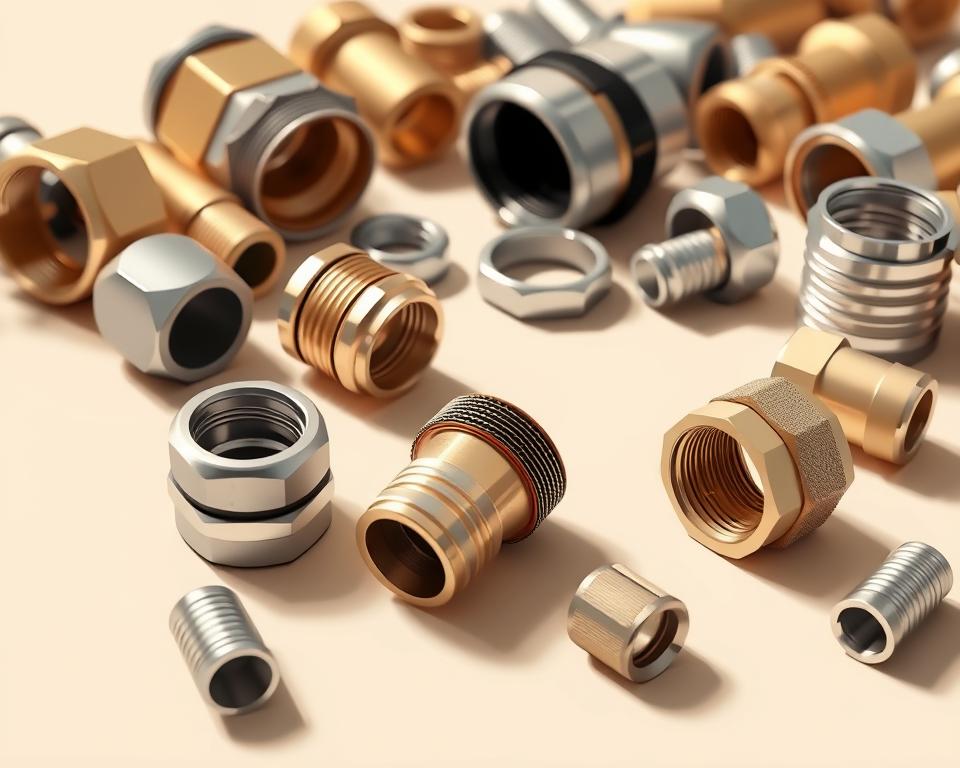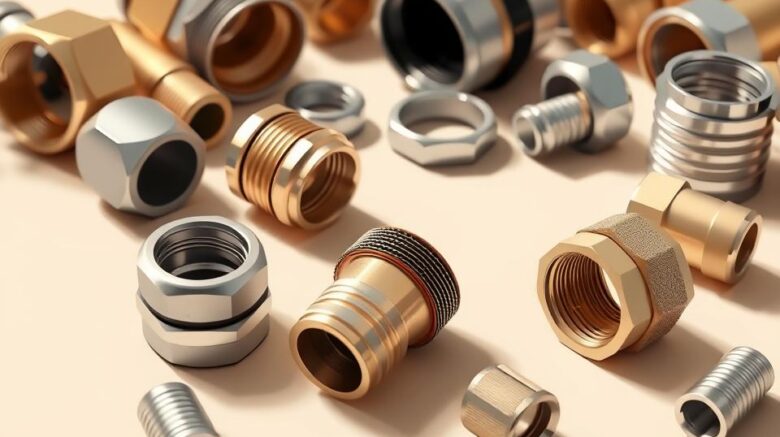Garden Hose Fittings Guide: Essential Yard Accessories
Puzzled by leaks and weak flow in your garden hose setup? Tiny what is garden hose thread called connectors—your standard garden hose fittings—often cause leaks and poor performance. They preserve flow, guard against leaks, and support a healthy yard.
Installation Parts Supply, a trusted provider of plumbing solutions, highlights that 67% of hose failures stem from poor-quality or mismatched connectors. The correct connectors matter for everything from a basic hose to a full irrigation system.
Most connectors follow the ANSI ¾”-11.5 NH thread size, ensuring broad compatibility. Refer to this guide for choosing robust fittings, testing pressure limits, and avoiding errors. Boost your hose setup without second thoughts!
Important Notes
- Good connectors halt leaks and save water.
- ANSI ¾”-11.5 NH (3/4″) is the universal thread size.
- Count on Installation Parts Supply for trusted fittings.
- Material and pressure ratings impact durability.
- Two-thirds of hose failures start at faulty connections.

The Importance of Picking Proper Garden Hose Fittings
Leaky fittings can dump far more water than you’d expect. Substandard parts are responsible for 40% of irrigation leaks. It’s as wasteful as a fully open indoor faucet left running.
Improper connectors cut water pressure by 15–20%. Sprinkler reach can suffer significantly. For pressure washers, experts recommend a maximum 50-ft hose length to maintain optimal flow.
Don’t overlook safety issues. A fitting blowout under pressure can be dangerous. Installation Parts Supply’s PSI-rated fittings guard against failures.
You need parts that last. Weatherproof materials extend service life in tough climates. Fast-disconnects can freeze and leak—inspect them seasonally.
Upgrading fittings once yielded a 35% improvement in sprinkler flow. Correct parts eliminate guesswork and deliver savings in water, time, and money.
Understanding Standard Garden Hose Fittings
Why do certain fittings endure while others give out quickly? It all depends on components such as ferrules, washers, and thread depth. Every component contributes to leak prevention and flow.
Grooved ferrules clamp the hose and prevent pull-offs. Plain ferrules suit high-PSI applications. Barbed collars grip strongly but may impede flow if misaligned.
Flat washers keep your fittings leak-free. A misaligned or worn washer causes most leaks. Press it firmly into the groove before tightening—this simple step saves water and frustration.
Proper thread engagement prevents gaps. Screw the male connector all the way into the female fitting. Unthreaded space equals water loss. One-piece connectors offer greater durability than separable designs.
Their anti-kink feature guards against kinks and wear. It prevents sharp bends that cause leaks. Pair it with regular O-ring checks (every 3 months) to keep seals pliable.
Durable couplings deliver reliable performance over time. Match the size and design to your needs, and you’ll avoid common pitfalls.
Choosing Your Hose Fitting Type
Overwhelmed by all the fitting types? Let’s simplify them. From quick-connects to pressure regulators, each type serves a unique purpose in your watering setup.
Quick-disconnect couplings make tool swaps a breeze. Brass quick-connects handle high pressure; plastic suits low-pressure use. Winter-proof valves prevent freeze damage.
Swivel fittings offer *270° rotation*, preventing kinks when moving sprinklers. For multi-tasking, Y-splitters divide flow between two hoses. Ideal when you need two hoses at once.
Pressure regulators smooth out surge fluctuations. They even out flow under varying supply pressures. Check the table below to compare costs and performance:
| Type | Material | Cost | Flow Rate (GPM) |
|---|---|---|---|
| Quick-Connect | Plastic | $1.50 | 4.2 |
| Quick-Connect | Brass | $8.00 | 5.1 |
| Y-Splitter | Aluminum | $6.50 | 3.8 (per outlet) |
Camlock couplers give tight seals in demanding applications. Camlock SS bodies fight rust and chemical attack. Always match thread sizes—most residential systems use ¾” connections.
Pro tip: Keep spare washers for each fitting type. Worn seals can sap pressure by 20% before visible drips appear.
Brass vs. Plastic vs. Aluminum
Connector materials determine strength and longevity. Plastic fittings max out around 150 PSI; brass goes up to 500 PSI. Lead-free brass fittings comply with Prop 65 for safe drinking water.
Aluminum outlasts plastic in sun exposure. Metal components stand up to harsh temperatures plastic can’t. Brass-aluminum hybrids deliver toughness and corrosion resistance.
When choose plastic? Drip irrigation and short-term use. See cost vs. PSI in the table:
| Type | Material | Cost | Max PSI |
|---|---|---|---|
| Coupler | Plastic | $4 | 150 |
| Coupler | Brass | $12 | 500 |
| Hybrid | Brass-Aluminum | $9 | 400 |
Select materials based on weather and pressure requirements. A single brass coupling beats plastic versions threefold in lifespan.
Garden Hose Sizing Guide: 3/4 Inch and Beyond
Hose diameter affects pressure and reach. 3/4″ hoses provide around 5 GPM. Smaller ⅝-inch lines max out at 3 GPM, ideal for gentle watering.
Every extra foot saps pressure. For every foot, expect a 1 PSI drop. Keep pressure-washer hoses under 50 ft for power. Installation Parts Supply’s adapters help bridge mismatched sizes without leaks.
Length vs. coverage:
- 25 ft: Perfect for small patios or container gardens.
- Reaches lawns up to 1,500 sq ft.
- Higher PSI needed for full coverage.
Large-scale irrigation uses 1″ connectors. Farms and large landscapes benefit from their extra capacity. Check this comparison for quick decisions:
| Diameter | Flow Rate (GPM) | Best For |
|---|---|---|
| ⅝ inch | 3 | Drip irrigation, small gardens |
| ¾ inch | 5 | Sprinklers, car washing |
| 1 inch | 7+ | Agriculture, large properties |
Plan your watering specs before you buy. 3/4″ works for most yards, but hose length is equally important. Use adapters to adapt hoses and tools without leaks.
Understanding PSI & Compatibility
Ever wonder why fittings blow out under spikes? The answer lies in PSI ratings. A 150 PSI connector might handle daily use, but spikes during valve closure can exceed 300 PSI—enough to burst weak parts.
Working PSI is different from burst PSI. A 300 PSI rating means the part withstands surges, not constant flow. Their industrial fittings endure surges—perfect for pressure washers and farms.
Sun-warmed hoses increase PSI. Temperature swings drive pressure up by roughly 5–10 PSI per 10°F. Allow extra hose length for thermal growth.
PSI Rating Comparison
| Rating | Best For | Burst Strength |
|---|---|---|
| 150 PSI | Residential sprinklers | 450 PSI |
| 300 PSI | Irrigation systems | 900 PSI |
| 600 PSI | Industrial use | 1,800 PSI |
Wrong threads are behind 30% of leaks. Bridge thread differences with properly rated adapters. A farm upgraded to 300 PSI brass fittings and cut water waste by 40%.
Checklist for Mixing Fittings
- Ensure threads match (ANSI ¾”-11.5 NH).
- Inspect washers for cracks before reusing.
- Verify PSI rating on older fittings.
- Swap out rusty or bent fittings.
Your hose and accessories define your pressure demands. Good planning stops fitting disasters.
Installation & Care Tips
Regular attention keeps leaks at bay. Inspect yearly for damage, corrosion, or wobble. Snug up loose fittings ASAP.
Leak checks take minutes. Connect, pressurize, and scan for leaking spots. Focus on joints first. Use their gauge to find invisible leaks.
Prepare for winter to avoid busts. Remove water and bring hoses indoors. Use insulated covers on outdoor spigots. This prevents bursts that can ruin your *hose needs*.
Their installation toolkit includes:
- Adjustable wrenches for secure tightening
- Plumber’s tape to seal threads
- A washer replacement guide for DIY fixes
Replace washers every 6 months. *Make sure* to pick the right size—a mismatch causes 30% of drips. Have spares on hand for quick fixes.
Store hoses coiled in shade. UV rays weaken materials over time. A hose reel ensures tidy, kink-free storage.
Stubborn drip? Try these fixes:
- Brush threads clean of grit
- Apply plumber’s grease to stiff O-rings
- Replace damaged washers right away
Conclusion: Nail the Right Hose Fittings
Perfect fittings are the foundation of an upgraded watering rig. Select brass, aluminum, quick-disconnect, or swivel based on your needs.
Premium connectors deliver long-term value. Brass fittings may cost more upfront but outlast plastics. Warrantied fittings ensure worry-free use.
Keep this guide handy:
- Check pressure ratings before buying
- Examine O-rings seasonally
- Winterize and store inside
Look out for next-gen fittings with built-in leak alarms. Meanwhile, ask the pros to get job done properly. Your garden hose rig deserves superior connectors!
